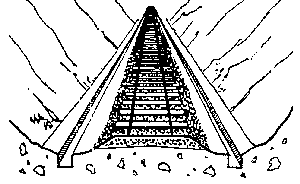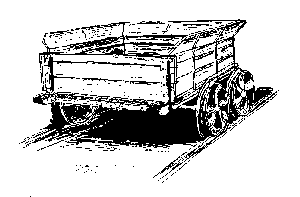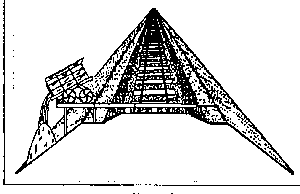|
|
|

|
Preservation and Restoration of NSW Railway Track Vehicles |
|
NSWGR Trikes |

|
©Copyright NSWGR Trikes 2016 |
|
Trikes and Trolleys A short history of track vehicles on the NSWGR
by Greg Lee |
|
Chapter 2 The Muck Dobbin
The importance of drainage in relation to track maintenance is probably not generally realised. It is not possible to have good track without good drainage. Since most railways in N.S.W. were built before the advent of earth moving machinery, the earthworks were of necessity limited to the minimum size necessary to allow the construction of the railway formation. This resulted in narrow cuttings, with room only for narrow drains. See Fig. 1.
Over a period of time these drains become silted up, and blocked with debris. If this situation is not corrected, water lies in the drains instead of draining away, and soaks into the ballast and the formation. The water carries mud with it, and in this way, bad drainage eventually leads to the track ballast being fouled with mud. Fouled ballast is not able to bear the loads transmitted from the track under the passage of trains, and so the track sinks into the ballast. (This phenomenon is analogous to the formation of pot holes in bitumen roads.) The end result is bad “top”, and the rough riding of trains.
The correction of such a situation is a costly and involved process. It requires the excavation of all of the fouled ballast, and replacement with new ballast. This can be done with the track in place, using a special on-track machine (in which case it is called “ballast cleaning”), or with the track removed (in which case it is called “reconditioning”). It should be noted that to simply place new ballast on top of the fouled ballast, and lift the track onto the new ballast does not solve the problem, and in fact usually exacerbates it.
Good track maintenance involves regular cleaning of drains, so that the ballast does not become fouled. These days this work is usually carried out with back hoes or excavators, and dump trucks. In days gone by, the work was carried out using horses and scoops, or men and shovels. It was of course necessary to provide a receptacle for the men to shovel into, and this receptacle took the form of the muck dobbin. See Fig. 2.
The muck dobbin consisted basically of a wooden tray mounted on a wooden frame, on wheels. Like the flat top trolley, it had simple “friction” cast iron axle boxes. The wooden frame was pivoted in the middle in such a way as to allow the tray to be manually tipped, even when full of mud. When a muck dobbin was filled with mud from the drains in a cutting, it would be pushed out of the cutting onto an embankment for emptying. Emptying was accomplished in an innovative manner. A portable turntable was provided, which was placed on top of the rails. The dobbin was pushed onto the turntable, which was then rotated until at right angles to the track. The dobbin was then pushed off the turntable onto specially placed rails sticking out over the side of the bank, where the mud would be tipped. See Fig. 3.
Muck dobbins were used for many years, probably from the earliest days of N.S.W. railways in 1855, up until the 1960s. In this time countless tons of mud were removed from cuttings and deposited over embankments. Large mounds of mud were thus created on many embankments, and these mounds may be observed in many places. They abound on the North Coast line, and can also be seen on the Dorrigo line (vegetation permitting).
Figure 1. Figure 2.
Figure 3. |
|
© Greg Lee, 1992 - 1999 |


